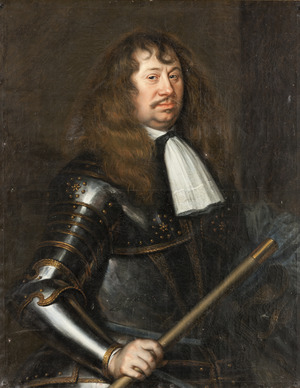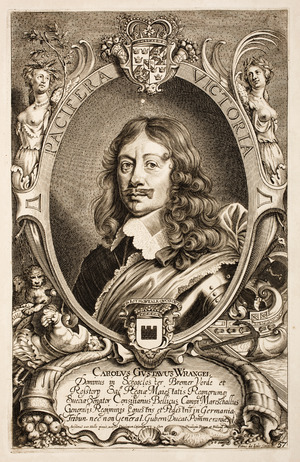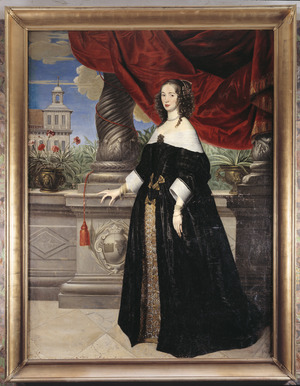Carl Gustaf Wrangel facts for kids
Quick facts for kids
Fältmarskalk Count
Carl Gustaf Wrangel
|
|
|---|---|

Carl Gustaf Wrangel in 1662 by Matthäus Merian the Younger.
|
|
| Born | 23 December 1613 Uppsala, Sweden |
| Died | 5 July 1676 (aged 62) Spyker on Rügen, Swedish Pomerania |
| Buried |
Skokloster, Sweden
|
| Allegiance | Sweden |
| Rank | Field Marshal, Lord High Admiral, Lord High Constable |
| Commands held | Commander-in-chief of the Swedish army in Germany |
| Battles/wars | Thirty Years War (incl. Torstenson War) War for Bremen Second Northern War Scanian War |
| Other work | Count of Salmis, later Sölvesborg Freiherr of Lindeberg and Ludenhof Governor-General of Swedish Pomerania Chancellor of the University of Greifswald Supreme Judge in the Uppland |
| Signature |  |
Carl Gustaf Wrangel (born December 23, 1613 – died July 5, 1676) was an important Swedish leader and military commander. He led Swedish forces in several major wars, including the Thirty Years' War, the Torstenson War, the War for Bremen, the Second Northern War, and the Scanian War.
Wrangel was from a Baltic German family. He rose through the ranks to become a field marshal, which is a very high military position. He was also the Commander-in-Chief of the Swedish army in Germany from 1646 to 1648. Later, he became the Lord High Admiral of Sweden in 1657, overseeing the navy.
Besides his military roles, Wrangel was also a powerful politician. He served as the Governor-General of Swedish Pomerania (a region then controlled by Sweden) for many years. From 1664, he was the Lord High Constable of Sweden, another very important position, and a member of the Privy Council of Sweden, which advised the king. He held the title of Count and owned many estates and castles, including Wrangelsburg, which is named after him.
Wrangel was a close friend of King Charles X Gustav of Sweden. He also served as a judge and the head of the University of Greifswald.
Contents
Family Life
Carl Gustaf Wrangel was born near Uppsala, Sweden, on December 23, 1613. His father was Herman Wrangel, and his mother was Baroness Margareta Grip av Vinäs. His family, the Wrangel family, had roots in the Baltic German region, with branches in Sweden, Russia, and Germany.
He married Anna Margareta von Haugwitz, who passed away in 1673. They had eleven children together, but sadly, six of them died when they were very young. The five children who grew up were:
- Carl Philipp Wrangel (died in London in 1668)
- Margareta Juliana Wrangel (born during the siege of Leipzig in 1642, married Nils Brahe the Younger)
- Polidora Christiana Wrangel (born in Spyker in 1655, married Leonard Johan Wirtenberg von Debern)
- Eleonora Sophia Wrangel (born in Wolgast in 1651, married Ernst Ludwig Freiherr von Putbus)
- Augusta Aurora Wrangel (born in Frederiksodde in 1658, died unmarried in 1699)
Early Military Career
Wrangel showed great skill in the military from a young age. At just 20 years old, he proved himself as a cavalry captain during the Thirty Years' War. Three years later, he became a colonel, and by 1638, he was a major-general, still serving in Germany.
In 1644, during the Torstenson War against Denmark, he led a Swedish fleet. His forces won an important naval battle against the Danes at Fehmarn on October 23.
In 1646, he returned to Germany as a Field Marshal. He took over as the Commander-in-chief of the Swedish army there from Lennart Torstenson. Under Wrangel's leadership, along with the French commander Turenne, the Swedish and French armies fought in Bavaria and Württemberg. After the Thirty Years' War ended in 1648, he was appointed Governor-General of Swedish Pomerania.
Serving King Charles X Gustav
Before Queen Christina stepped down from the throne, Carl Gustaf Wrangel was already a close friend and trusted advisor to the next king, Charles X Gustav of Sweden. They had first met before the Battle of Leipzig in 1642. King Charles X Gustav even became the godfather to Wrangel's oldest daughter when she was born during the siege of Leipzig.
King Charles X Gustav gave Wrangel the title of freiherr of Ludenhof and made him the Lord High Admiral of Sweden. This was a special honor because the king usually left many high positions empty.
When the Second Northern War began in 1655, Wrangel first commanded a fleet. But in 1656, he was back on land, leading troops alongside Frederick William I of Brandenburg in the three-day Battle of Warsaw (1656). In 1657, he led an invasion of Jutland. In 1658, he famously marched his army across the frozen ice to capture the fortress of Kronborg.
After King Charles X Gustav died in 1660, Wrangel helped organize the funeral and even composed a sad song for the occasion. In the same year, he became the head of the University of Greifswald. Two years earlier, he had been made a supreme judge in the Uppland Province of Sweden.
Serving King Charles XI
In 1664, Carl Gustaf Wrangel was given the very important role of Lord High Constable of Sweden. This meant he was a key member of the Privy Council of Sweden, which advised the young King Charles XI of Sweden while he was still a minor.
During the Wars for Bremen, Wrangel tried to capture the city of Bremen for Sweden, but he was not successful. He was forced to sign a peace treaty called the Peace of Habenhausen on November 15, 1666.
Later, during the Scanian War, Wrangel's health was failing, and he could not command effectively. He was called back from duty after his stepbrother, Baron Waldemar Wrangel, was defeated at Fehrbellin during a Swedish invasion.
Later Life and Passing
Carl Gustaf Wrangel suffered from many health problems throughout his life, including gout and gallstone. These issues were made worse by the difficult conditions and injuries he experienced during his many military campaigns. He tried various health resorts, but he never fully recovered. In 1674, he became very ill, and his chronic diseases made it almost impossible for him to lead the Swedish forces in the Scanian War.
Wrangel passed away shortly after, on July 5, 1676, at his Spyker Castle on Rügen, which was then part of Swedish Pomerania. His body was first taken to Stralsund. Even during the siege of 1678, his body remained there. After the battle, the city fell to Danish and Brandenburg forces. However, the Danish king and the Brandenburg ruler allowed Wrangel's body to be moved to Stockholm in July 1680. On December 1, 1680, he was finally buried in the Wrangel family's crypt at Skokloster Castle. His important writings and documents are kept in the Great Imperial Archive in Stockholm.
Landowner and Builder
Carl Gustaf Wrangel became one of the largest landowners in Swedish Pomerania. He owned many estates and properties, including Spyker on Rügen, Wrangelsburg, and Mölschow on Usedom. He also held lands in Swedish Livonia, Scania, and near Stockholm. He even owned property in Finland and Halland.
Wrangel was also a great builder. He constructed several grand palaces, including Gripenberg Palace, and palaces in Bremervörde, Skokloster, Spyker, Stralsund, and Wrangelsburg. The town of Wrangelsburg was even renamed by him in 1653. His favorite and most magnificent castle was Skokloster Castle in Uppland. Here, he gathered impressive collections of art, valuable weapons, and interesting items from around the world.
See also
 In Spanish: Carl Gustaf Wrangel para niños
In Spanish: Carl Gustaf Wrangel para niños








